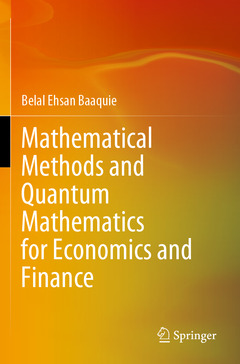Mathematical Methods and Quantum Mathematics for Economics and Finance, 1st ed. 2020
Auteur : Baaquie Belal Ehsan

PART I : INTRODUCTION
1 Introduction
1.1 Introduction
1.2 Elementary Algebra
1.2.1 Quadratic polynomial
1.3 Finite Series
1.4 Infinite Series
1.4.1 Cauchy convergence
1.5 Problems
2 Functions
2.1 Introduction
2.2 Exponential function
2.3 Demand and supply function
2.4 Option theory payoff2.5 Interest rates; bonds
2.6 Problems
PART II : LINEAR ALGEBRA
3 Simultaneous linear equations
3.1 Introduction
3.2 Two commodities
3.3 Vectors
3.4 Basis vectors
3.4.1 Scalar product
3.5 Linear transformations; matrices
3.6 EN: N-dimensional linear vector space
3.7 Linear transformations of EN
3.8 Problems
4 Matrices
4.1 Introduction
4.2 Matrix multiplication
4.3 Properties of N × N matrices
4.4 System of linear equations
4.5 Determinant: 2 × 2 case
4.6 Inverse of a 2 × 2 matrix
4.7 Outer product; transpose
4.7.1 Transpose
4.8 Eigenvalues and eigenvectors
4.8.1 Spectral decomposition
4.9 Problems
5 Square matrices
5.1 Determinant: 3 × 3 case
5.2 Properties of determinants
5.3 N × N determinant
5.3.1 Inverse of a N × N matrix
5.4 Leontief input-output model
5.4.1 Hawkins-Simon condition
5.5 Symmetric matrices
5.6 Symmetric matrix: diagonalization5.6.1 Functions of a symmetric matrix
5.7 Hermitian matrices
5.8 Diagonalizable matrices
5.8.1 Non-symmetric matrix
5.9 Change of Basis states
5.9.1 Symmetric matrix: change of basis
5.9.2 Hermitian matrix: change of basis
5.10 Problems
PART III : CALCULUS
6 Integration6.1 Introduction
6.2 Sums leading to integrals
6.3 Definite and indefinite integrals
6.4 Applications in economics
6.5 Multiple Integrals
6.5.1 Change of variables
6.6 Gaussian integration
6.6.1 N-dimensional Gaussian integration
6.7 Problems
7 Differentiation
7.1 Introduction
7.2 Inverse of Integration
7.3 Rules of differentiation7.4 Integration by parts
7.5 Taylor expansion
7.6 Minimum and maximum
7.6.1 Maximizing profit7.7 Integration; change of variable
7.8 Partial derivatives
7.8.1 Chain rule; Jacobian
7.8.2 Polar coordinates; Gaussian integration7.9 Hessian matrix: critical points
7.10 Constrained optimization: Lagrange multiplier
7.10.1 Interpretation of λc
7.11 Line integral; Exact and inexact differentials
7.12 Problems
8 Functional analysis
8.1 Dirac bracket and vector notation
8.2 Continuous basis states
8.3 Dirac delta function
8.4 Basis states for function space
8.5 Operators on function space
8.6 Gaussian kernel
8.7 Fourier Transform
8.8 Taylor expansion
8.9 Gaussian functional integration
8.10 Problems
9 Ordinary Differential Equations
9.1 Introduction
9.2 Separable differential equations9.3 Linear differential equations
9.4 Bernoulli differential equation
9.5 Homegeneous differential equation
9.6 Second order linear differential equations
9.6.1 Single eigenvalue
9.7 Ricatti differential equation
9.8 Inhomogeneous second order differential equations
9.8.1 Green’s function
9.9 System of linear differential equations
9.10 Strum-Louisville theorem; special functions
9.11 Problems
PART IV : PROBABILITY THEORY
10 Random variables
10.1 Introduction: Risk
10.1.1 Example
10.2 Key ideas of probability
10.3 Discrete random variables
10.3.1 Bernoulli random variable
10.3.2 Binomial random variable
10.3.3 Poisson random variable
10.4 Continuous random variables
10.4.1 Uniform random variable
10.4.2 Exponential random variable
10.4.3 Normal (Gaussian) random variable
10.5 Problems
11 Probability distribution functions
11.0.1 Cumulative density
11.1 Axioms of probability theory11.2 Joint probability density
11.3 Independent random variables
11.3.1 Law of large numbers
11.4 Correlated random variables
11.5 Marginal probability density
11.6 Conditional expectation value
11.6.1 Discrete random variable
11.6.2 Continuous random variables
11.7 Problems12 Stochastic processes & Option pricing
12.1 Gaussian white noise
12.1.1 Integrals of White Noise
12.2 Ito Calculus
12.3 Lognormal Stock Price
12.4 Black-Scholes Equation; Hedged Portfolio
12.4.1 Assumptions in the Derivation of Black-Scholes
12.5 Risk-Neutral Martingale Solution of the Black-Scholes Equation
12.6 Black-Scholes-Schrodinger equation
12.7 Linear Langevin Equation
12.7.1 Random Paths
12.8 Problems
13 Appendix
13.1 Introduction
13.2 Integers
13.3 Real numbers
13.4 Cantor’s Diagonal Argument
13.5 Higher Order Infinities
13.6 Mathematical LogicProf. Belal Ehsan Baaquie holds a B.S. in Physics from Caltech and a Ph.D. in Theoretical Physics from Cornell University, USA. His main research interest is in the study and application of mathematical methods from quantum field theory. He has applied the mathematical formalism of field theory to finance and been a major contributor to the emerging field of quantum finance. His current focus is on developing the formalism of quantum finance and applying it to option pricing, corporate coupon bonds, and the theory of interest rates, as well as the study of equity, foreign exchange, and commodities. He is also applying methodologies from statistical mechanics and quantum field theory to the study of microeconomics and macroeconomics.
Provides a concise and up-to-date introduction for all graduate students studying finance/quantitative finance
Includes a wealth of examples and exercises to promote student comprehension
Discusses the Black-Scholes equation to help students understand the mathematical underpinning of financial instruments
Date de parution : 08-2021
Ouvrage de 432 p.
15.5x23.5 cm
Date de parution : 08-2020
Ouvrage de 432 p.
15.5x23.5 cm
Thèmes de Mathematical Methods and Quantum Mathematics for... :
Mots-clés :
Square matrices; Indefinite integrals; Hessian matrix; Gaussian integration; Quantitative finance; Separable diffferential equations; Discrete random variables; Probability distribution functions; Lognormal stock price; Black-Scholes-Schrodinger equation; Risk-Neutral Martingale solution; Linear Langevin equation; Hedged portfolio



